This article was medically reviewed by Shari Forschen, NP, MA. Shari Forschen is a Registered Nurse at Sanford Health in North Dakota. Shari has worked in healthcare since 1996 and her expertise lies in acute care bedside nursing on a medical oncology floor. She received her degree from Medcenter one College of Nursing in 2003 and her Family Nurse Practitioner Masters from the University of North Dakota in 2014. Shari is a member of the American Nurses Association.
There are 8 references cited in this article, which can be found at the bottom of the page.
wikiHow marks an article as reader-approved once it receives enough positive feedback. This article received 18 testimonials and 82% of readers who voted found it helpful, earning it our reader-approved status.
This article has been viewed 227,962 times.
Menstrual cramps can range from mild to debilitating, which makes them especially difficult to contend with when you’re not home. Thankfully many common remedies can be adapted for use at school or work. By relaxing cramping muscles, reducing your pain and using coping strategies designed for when you’re out of the house, you can relieve cramps on the go and get on with your day.
Steps
Relaxing Cramping Muscles
-
1Take deep breaths. Deep breaths flood your blood with oxygen and can reduce muscle cramps. Breathe in deeply through your nose and out through your mouth, letting your belly relax outward as you draw air deep into your diaphragm. You can perform a set of 10 deep breaths for optimal relaxation. This can easily be done in class or in your office.[1]
-
2Apply pressure to reflexology pressure points. There are some easily accessible pressure points you can use to reduce menstrual cramping. One is located 4 finger widths below your navel, and one is located on the front of each hipbone. Use your middle finger to apply slow, firm pressure at each point, holding each one for 2-3 minutes to start. You can do this discreetly over your clothes while sitting in a meeting or while you read in school.[2]
- Don’t hold these points for longer than 10 minutes at a time, which may cause soreness. After performing one session of 2-3 minutes, you can do another if it feels comfortable.
Advertisement -
3Massage your abdomen and lower back in small circles. Massage can increase circulation and bring more blood to the area to relieve muscle cramping. Follow your discomfort to provide the most relief: If your lower back is hurting, rub small circles near your spine with your thumb, which is your most powerful finger. If you have lower abdominal cramping, use your thumbs to massage in a circular motion from hip bone to hip bone across your belly.[3]
- Circular motions can penetrate more deeply and bring better circulation to the area than more sweeping motions. If a different massage pattern feels good though, just do whatever lessens your discomfort.
- This massage is discreet and can be performed over your clothes in the car or when seated during your work or school day.
-
4Drink lots of water. Being well-hydrated eases muscle cramping and can reduce period pain. Aim to get 2 liters (or half a gallon) of water a day, especially when you’re having cramps. You can carry a water bottle with you on the go and refill over the course of your day.[4]
-
5Apply a few drops of essential oils. Essential oils can reduce tension and help naturally balance the hormones that cause bad menstrual cramping. Apply 2-3 drops of peppermint or clary sage oil to the inside of your wrist, so you can take a sniff during the day. If you find the scent to be distracting when you eat or drink, you can apply the drops directly to your abdominal area. Although some studies support the use of aromatherapy for cramps, more research needs to be done to determine whether it is safe and effective. [5]
- You can keep a bottle of oil in your book bag or laptop bag, so you can address your discomfort on the go.
- Do not apply more essential oil than directed. It is also not for use internally.
Reducing Pain
-
1Create a makeshift heat pad using paper towels. Heat increases blood flow to cramping muscles and can be a strong, relaxing pain reliever. If you have access to a microwave, in a work break room for example, dampen some paper towels and heat them in 30-second increments in the microwave until they are warm but not steaming. Take them to the bathroom and apply to your lower back for some soothing pain relief.
- If you don’t want to risk making your clothes damp, it may be helpful to sit on the toilet. This way you can apply the heated paper towels to your lower back with your pants or skirt lowered.
- If you don’t have access to a microwave, you can still employ heat to soothe your cramps. Run some paper towels under hot water in the bathroom. Wring them well and place on your abdomen or lower back to soothe your cramping.
-
2Take the stairs or walk the hall. Exercise produces endorphins, which are your body’s natural pain relievers. Since you likely can’t put in a treadmill session on the go, try to incorporate easy exercise into your work or school day to boost your endorphins and provide some natural cramping relief. You could take the stairs instead of the elevator or walk outside during a free period.[6]
Coping When You’re Out All Day
-
1Apply a personal heating pad. A personal heating pad, such as a Thermacare patch, is activated by exposure to the air and is invisible underneath your clothes. Wearing one can reduce cramping and relieve pain without needing to perform the paper towel method. Many patches stay warm for up to 8 hours, and you can apply them directly to the abdomen or back for relief.
- Keep a patch in your car or book bag, so you’ll always have one handy in case you need it.
-
2Ask a friend for OTC pain medication or carry a small bottle with you. Over-the-counter pain medications, such as ibuprofen and acetaminophen, can reduce your pain and make you more comfortable. For the best pain relief, take these medications at the onset of your cramping and continue while you are experiencing symptoms. It’s generally more effective to get ahead of the pain with medication when it is mild, than to blunt the pain once it is already very strong.[7]
- Ibuprofen dosage is 200 to 400mg orally every 4 to 6 hours as needed. Acetaminophen dosage is 500-1000mg every 6 hours as needed.
- If you’re at a hotel or restaurant for a business meeting, you can also ask the concierge or maître d’ for a painkiller. Many keep a stock of common OTC medications for staff members and are happy to share one with patrons.
- If you find your cramps begin and you don’t have any medication with you, ask a friend if they have a capsule to spare.
-
3Switch to maxi pads. While tampons are very convenient, they may irritate the cervix, aggravating cramping. If your cramping is very intense, it may be worth switching to pads for a day in case some topical irritation is increasing your discomfort. Most public restrooms in schools and offices have pads available in the menstrual-product vending machines.[8]
Expert Q&A
Did you know you can get expert answers for this article?
Unlock expert answers by supporting wikiHow
-
QuestionHow do you prevent yourself from getting freaked out when you have your first period?
 Shari Forschen, NP, MAShari Forschen is a Registered Nurse at Sanford Health in North Dakota. Shari has worked in healthcare since 1996 and her expertise lies in acute care bedside nursing on a medical oncology floor. She received her degree from Medcenter one College of Nursing in 2003 and her Family Nurse Practitioner Masters from the University of North Dakota in 2014. Shari is a member of the American Nurses Association.
Shari Forschen, NP, MAShari Forschen is a Registered Nurse at Sanford Health in North Dakota. Shari has worked in healthcare since 1996 and her expertise lies in acute care bedside nursing on a medical oncology floor. She received her degree from Medcenter one College of Nursing in 2003 and her Family Nurse Practitioner Masters from the University of North Dakota in 2014. Shari is a member of the American Nurses Association.
Master's Degree, Nursing, University of North Dakota
-
QuestionI have muscles cramps and I am working. What can I do about it while I am at work?
 Shari Forschen, NP, MAShari Forschen is a Registered Nurse at Sanford Health in North Dakota. Shari has worked in healthcare since 1996 and her expertise lies in acute care bedside nursing on a medical oncology floor. She received her degree from Medcenter one College of Nursing in 2003 and her Family Nurse Practitioner Masters from the University of North Dakota in 2014. Shari is a member of the American Nurses Association.
Shari Forschen, NP, MAShari Forschen is a Registered Nurse at Sanford Health in North Dakota. Shari has worked in healthcare since 1996 and her expertise lies in acute care bedside nursing on a medical oncology floor. She received her degree from Medcenter one College of Nursing in 2003 and her Family Nurse Practitioner Masters from the University of North Dakota in 2014. Shari is a member of the American Nurses Association.
Master's Degree, Nursing, University of North Dakota
-
QuestionWhat if you are at school and you can't lay down?
 Shari Forschen, NP, MAShari Forschen is a Registered Nurse at Sanford Health in North Dakota. Shari has worked in healthcare since 1996 and her expertise lies in acute care bedside nursing on a medical oncology floor. She received her degree from Medcenter one College of Nursing in 2003 and her Family Nurse Practitioner Masters from the University of North Dakota in 2014. Shari is a member of the American Nurses Association.
Shari Forschen, NP, MAShari Forschen is a Registered Nurse at Sanford Health in North Dakota. Shari has worked in healthcare since 1996 and her expertise lies in acute care bedside nursing on a medical oncology floor. She received her degree from Medcenter one College of Nursing in 2003 and her Family Nurse Practitioner Masters from the University of North Dakota in 2014. Shari is a member of the American Nurses Association.
Master's Degree, Nursing, University of North Dakota
References
- ↑ https://www.plannedparenthood.org/learn/health-and-wellness/menstruation/what-can-i-do-about-cramps-and-pms
- ↑ https://bpsmedicine.biomedcentral.com/articles/10.1186/s13030-019-0165-0
- ↑ https://www.ncbi.nlm.nih.gov/pmc/articles/PMC3093183/
- ↑ https://www.webmd.com/women/ss/slideshow-get-rid-of-cramps
- ↑ https://www.ncbi.nlm.nih.gov/pmc/articles/PMC6262530/
- ↑ http://www.mayoclinic.org/diseases-conditions/menstrual-cramps/basics/lifestyle-home-remedies/con-20025447
- ↑ https://www.uofmhealth.org/health-library/aq0001
- ↑ https://www.healthlinkbc.ca/health-topics/hw178944spec
About This Article
Menstrual cramps can be mild to severe, which can make them especially hard to deal with when you’re not home. However, there are lots of common remedies that can help you feel better quickly. Deep breaths flood your blood with oxygen, which can reduce cramps, so try inhaling deeply through your nose and exhaling through your mouth while you relax your belly. Try a set of 10 deep breaths to relieve your cramps. Another way to reduce cramping is to stay well-hydrated, so aim to get 2 liters of water a day. Bananas can also help keep you hydrated and give you a healthy dose of potassium, which can help your discomfort. For more tips from our Medical co-author, including how to use essential oils to reduce period cramps, keep reading!
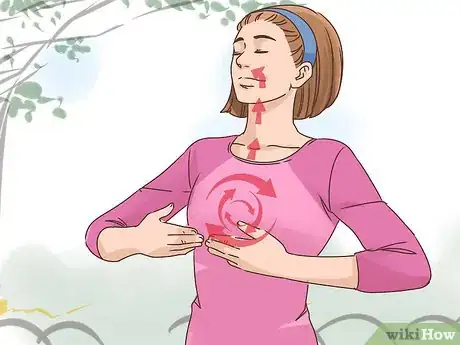

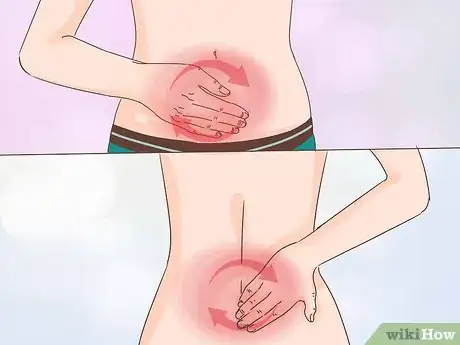
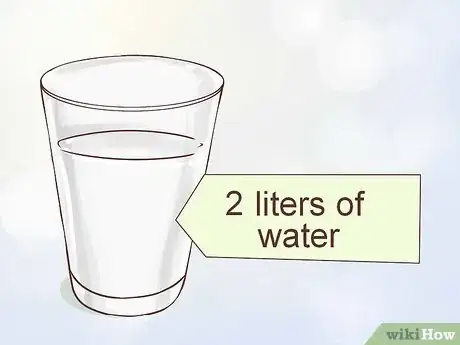
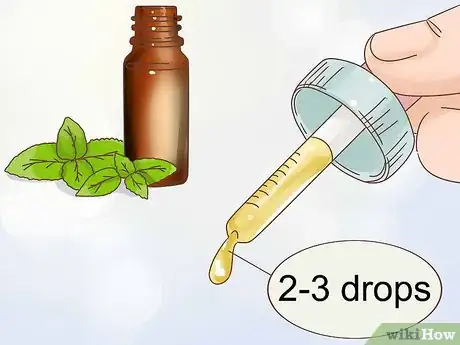
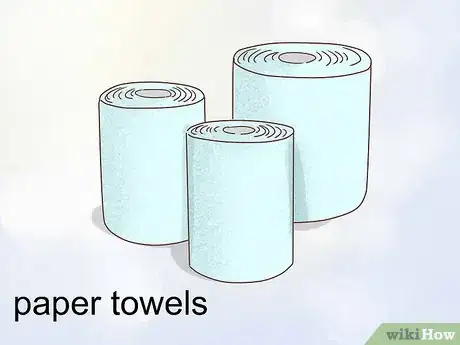

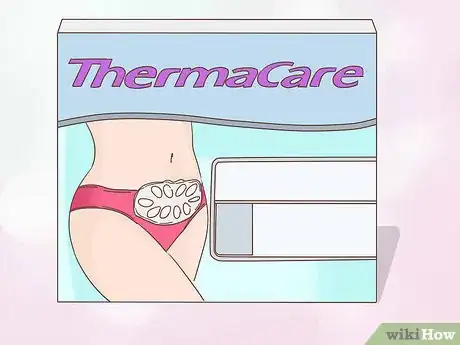
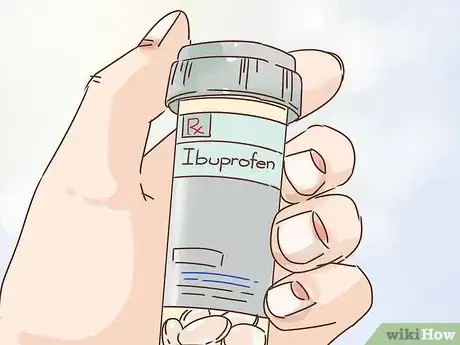

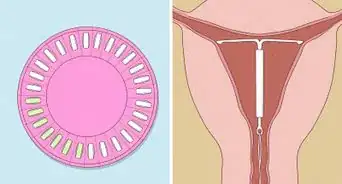
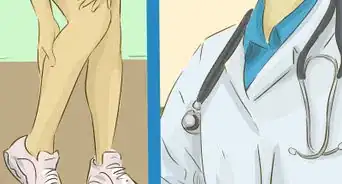




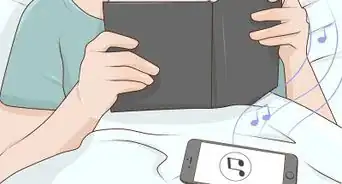


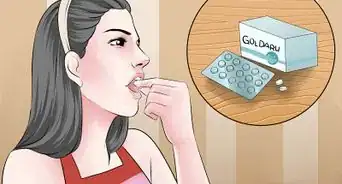











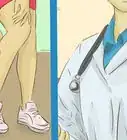
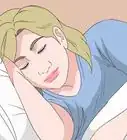




































Medical Disclaimer
The content of this article is not intended to be a substitute for professional medical advice, examination, diagnosis, or treatment. You should always contact your doctor or other qualified healthcare professional before starting, changing, or stopping any kind of health treatment.
Read More...